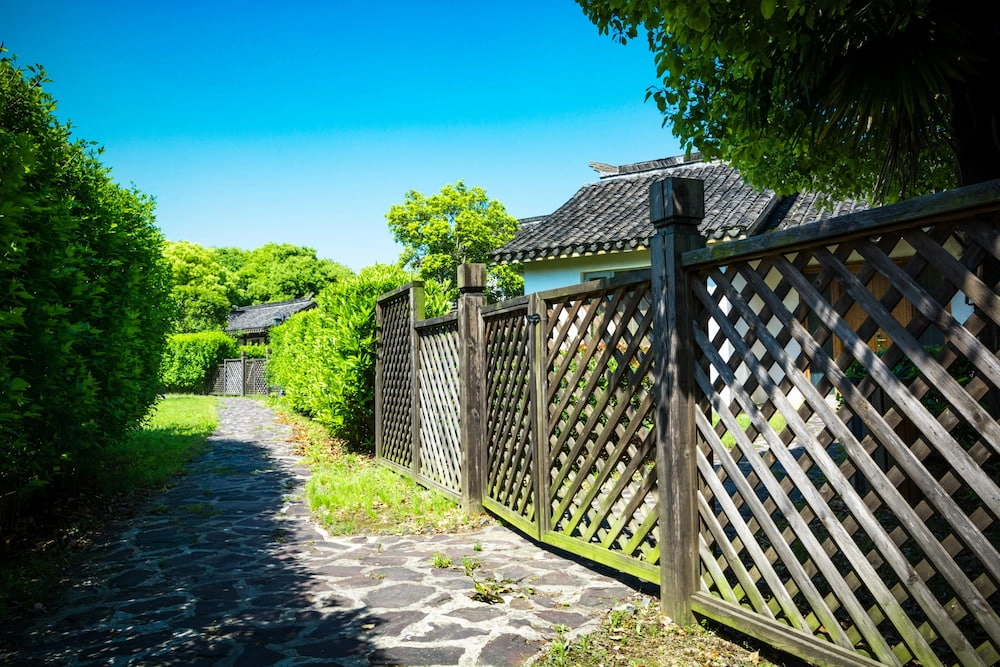Residents often face the need to install fences in a private houses, unlike their European and American colleagues, who resort to such measures less often. Fences not only enhance security but also help to define the boundaries of property, preventing possible territorial disputes.
Guide to DIY Fencing for Your Yard
Determining the boundaries of a plot
Before you start building, it is extremely important to accurately determine the boundaries of your site. Do not make the mistake of going beyond these boundaries, even by a few millimeters, as this can lead to serious consequences, including administrative inspections and fines from city authorities and land committees requiring the dismantling of the fence.
Interaction with neighbors
Before you start building, it is important to discuss your plan with your neighbors. This will prevent future disputes regarding the height and transparency of the fence. The ideal fence should not exceed 1.5 meters and be transparent enough not to create a shadow for neighboring areas. The materials for the fence on the garden plot should be safe, not heat up in the sun, not retain moisture, and not emit harmful substances.
Cooperation with neighbors can include co-financing the cost of a fence, making construction more cost-effective, and promoting good neighborly relations.
Selecting the design and materials for a fence for a private house
Depending on the available finances, you can consider different methods of installing a fence. The most durable and long-lasting options are built on screw or bored piles, but this is also the most expensive option. An alternative is a fence on a strip foundation, which also requires significant investment and special attention to the choice of soil due to its sensitivity to heaving.
If you prefer to save money, you can choose less expensive materials, such as corrugated sheets, chain-link fencing, or metal pickets, which are installed on a metal frame. It is important to consider that different materials have different requirements for installation and resistance to wind loads.
important: Looking for reliable local fencing companies near Broken Arrow, OK? Get expert fence installation and repair services today. Contact us for a free quote!
Determining the correct distances between posts
When choosing a material, you should also consider possible loads and ensure adequate ventilation. Chain-link fencing does not create significant wind resistance, and therefore the posts can be installed at a distance of up to 3 m. For corrugated sheets, the recommended distance between posts is from 2 to 2.5 m, and in open areas – no more than 2 m for additional stability.
The installation of the posts requires precision: it is necessary to measure the perimeter of the installation and correctly distribute the posts so that the distance between them is optimal and ensures the strength of the entire structure. The square cross-section of the posts is preferable for welded joints, as it ensures greater reliability and an aesthetic appearance of the entire fence.
Basics of choosing the depth of the foundation for a fence depending on the type of soil
The choice of foundation depth for installing a fence critically depends on the type of soil on the site. For example, for dense clay and loamy soils, it is recommended to dig 200-300 mm below the freezing level, which in conditions similar to the Moscow region means the need to dig to a depth of about 1500 mm. It is always useful to consult with local construction specialists to determine the exact depth.
For soils that are less susceptible to heaving, such as sandy or rocky soils, it may be sufficient to set fence posts at a depth of between 600mm and 1200mm, although the standard recommendation is 1500mm to allow for potential wind loads.
In marshy areas, it is preferable to use screw piles, which can be deepened according to individual calculations based on geological surveys of the area.
Selection of materials and construction of the fence
When choosing materials to build a fence, you should consider not only their cost, but also the characteristics of the soil, climatic conditions, and landscape features of the site. Materials such as corrugated sheets or metal pickets are easy to install on a metal frame and have good wind characteristics. However, if the distance between the posts exceeds certain standards, this may lead to the need for additional reinforcement of the fence.
For the fence frame construction, it is recommended to use square posts with a cross-section of 20*40 mm and a wall thickness of 1.5 mm. The installation of three horizontal purlins increases the stability and durability of the fence, especially if its height is more than 2 meters.
Place the horizontal purlins so that they connect to the frame, ensuring the strength and aesthetics of the structure. If the fence is adjacent to neighbors, you can consider the possibility of sharing the costs of its installation.
Purchasing fencing materials
Go to a construction site or look for a local supplier that offers fencing materials. It is recommended to compare prices from different sellers to find the best deal.
Protective treatment of fence posts
Before installing the fence, start by waterproofing the posts. Use bitumen, rubber-bitumen, or polymer insulation materials available in hardware stores. It is important to carefully read the instructions for the use of the selected product to choose the most appropriate application method.
Marking out the place for the fence
Use a measuring cord to determine the fence installation points on the site. Next, drill holes at the intended locations of the main supports. Add and compact a layer of gravel or crushed stone to each hole to prevent subsidence. Install the outer posts, checking their verticality with a building level.
Strengthening the foundation of the fence
Recently, concreting of pillars has become a generally accepted method, ensuring the reliability of the foundation. After installing all the pillars along a stretched cord or by level, you can pour a reinforced concrete strip, increasing the stability of the fence and protecting against undermining.
Completion of the fence construction
After concreting the posts, leave them for a couple of days to harden, after which you can begin priming and painting the metal frame of the fence, which will give the fence a finished and neat look.
Installation of fencing
Start by installing horizontal purlins for the corrugated sheets. Then, attach the corrugated sheets using roofing screws. If you have chosen other materials, such as chain-link fencing, first roll it out and carefully stretch it next to the posts, reinforcing the supporting wire to prevent sagging. For fences higher than two meters, install additional reinforcements at the top and bottom.
Advice from the experts on building fences
In this section, we have collected useful tips from experienced professionals that will make the process of installing a construction fence easier. If construction work includes complex tasks such as drilling, welding, and painting, it is better to plan them for the warm season. Make sure that the length of the fence corresponds to the size of your site and does not extend beyond it.
When designing a fence, it is necessary to adhere to building codes and regulations, such as SNiP 30-02-97 and SP 11-106-97, which regulate the planning and development of territories. Also, follow the unofficial rules for building fences to avoid conflicts, for example, install the fence strictly within the boundaries of your site or along its border, without encroaching on the territory of neighbors.
Read Other: Reasons to Work With a Kitchen Designer






More Stories
Boston Bruins Jersey Trends | CJP Apparel
Online Lawyer Consultation: You’re Guide to Legal Advice from Home
Designs Paintball Jerseys | Custom Paintball